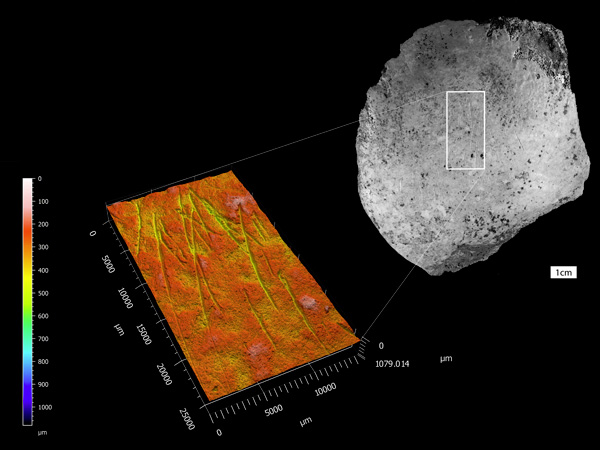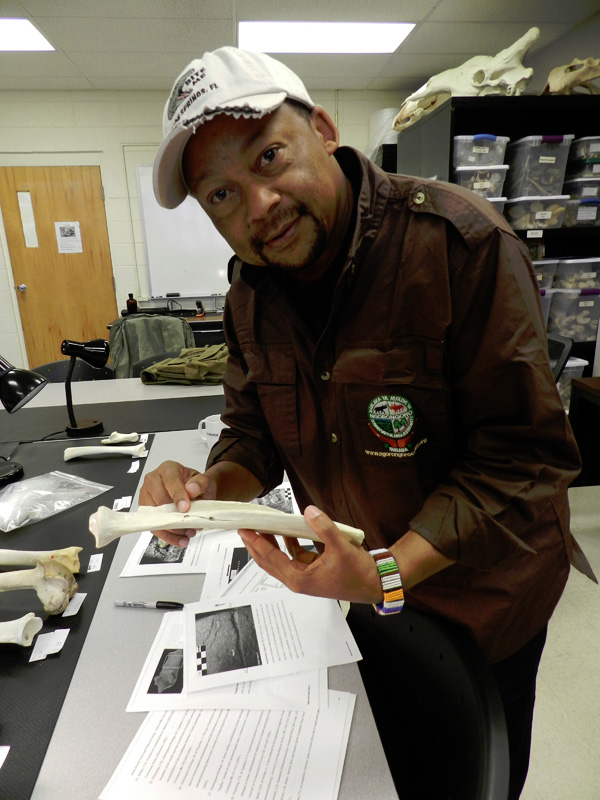You might wonder why an anthropologist would want an expensive imaging device. And, in fact, most anthropologists would not be interested in such technology. However, paleoanthropologists look in the most unlikely places for evidence of the behavior of our ancestors. Dr. Michael Pante, Assistant Professor in the Department of Anthropology at Colorado State University (CSU), is a paleoanthropologist that is interested in the evolution and feeding behavior of early members of the genus Homo. Dr. Pante requested funding to purchase an instrument called a non-contact white light confocal profilometer from Nanovea because he started using this technology when he was a Research Associate at the Institute of Archaeology, University College London. The CSU College of Liberal Arts Dean’s office provided funding for this equipment, in part to broaden the research profile of the college.
Dr. Pante’s current work is at Olduvai Gorge, Tanzania as a senior zooarchaeologist for the Olduvai Geochronology and Archaeology Project (OGAP), a collaborator with the Olduvai Landscape Paleoanthropology Project (OLAPP), and the co-director of the Olduvai Project field school. At this renowned UNESCO world heritage site, Dr. Pante examines the butchery and tooth marks left by both human ancestors and the carnivores that they were competing with on fossilized fauna to unravel the feeding behavior and ecology of early humans. His current research is focused on understanding the impact of meat and marrow consumption on human evolution through the study of 1.5-1.8 million year old faunal assemblages. These assemblages coincide with a technological revolution that occurred when our ancestors shifted from the first and most primitive stone technology, called the Oldowan to more sophisticated stone tools known as Acheulean handaxes. This cultural transition was a pivotal moment in human evolution and is associated with the appearance of a new species, Homo erectus, and with a dietary shift towards increasing carnivory that may have been central to the evolution of our own species, Homo sapiens.
Dr. Pante is using this technology in part to understand the differences between marks left on fossils from stone tools and those left by carnivore teeth. The Nanovea ST400 profilometer is a uniquely capable instrument for this task because it collects surface profiles and roughness data. It is also accurate at the nanometer scale when measuring depth allowing the detection of micromorphological features in the marks found on fossils that cannot be observed using more conventional methods like traditional microscopy. The ST400 is capable of scanning large areas up to 225 cm2 and is also equipped with a microscope that allows accurate identification of the area that will be scanned. Beyond the benefits to Anthropology the device also has applications in semiconductors, microelectronics, solar energy, fiber optics, aerospace, machining, and biomedical science.
The profilometer is located in Dr. Pante’s Paleoanthropology and Zooarchaeology Laboratory and is open to use by appointment encouraging collaboration between CSU departments as well as outside the university. The profilometer has been in the Department of Anthropology since August and three of Dr. Pante’s colleagues have already taken advantage of the asset. Dr. Stephen Merritt, Assistant Professor in the Department of Anthropology at the University of Alabama at Birmingham and Dr. Jackson Njau, Assistant Professor in the Department of Geological Sciences at Indiana University and a Research Associate at the Stone Age Institute in Bloomington, Indiana have traveled to Fort Collins to visit Dr. Pante’s lab and use the ST400 Profilometer, while Dr. David Braun, Associate Professor of Anthropology at The George Washington University sent samples for analysis by Dr. Pante and his graduate students. There are many ways for faculty and students to incorporate this technology into their research and the CSU Department of Anthropology welcomes colleagues to take advantage of our new asset.



